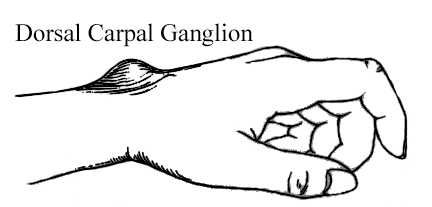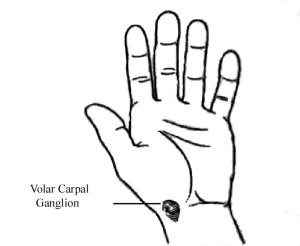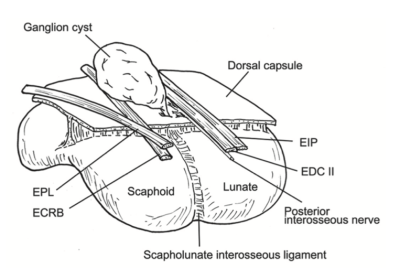Wrist Ganglion cyst
What is a Ganglion Cyst?
A ganglion cyst is the most common lump that develops in the hand or wrist. Ganglion cysts are benign (harmless) swellings. A ganglion is a fluid-filled sac arising from a joint or tendon sheath. A ganglion can form from almost any joint or tendon sheath in the wrist or hand.
What are the causes?
The exact cause of ganglion cysts remains uncertain. The most popular theory is that ganglion cysts form after trauma or degeneration of ligaments, tendon sheath or joint. Increased joint or tendon sheath fluid is produced, and the cyst fills up with fluid outside the joint or tendon sheath, much like a balloon. The cyst will occasionally change size if fluid leaks from it.
Wrist ganglion cysts
Ganglions of the wrist often occur in teenagers and young adults. They are so common that one study showed 40% of adults having an MRI will have a ganglion, and most of them do not cause symptoms. Ganglions can be so small that they are not visible or there may be a swelling under the skin on the back or underside of the wrist. In older patients there may be a sign of underlying arthritis causing increased fluid production in the joint. If there is any suspicion of arthritis, an x-ray will be arranged.


Symptoms
Apart from the localised swelling, wrist ganglions may cause pain with loading and gripping, particularly when putting your bodyweight through the hand. The symptoms may last a week or two then settle again, only to recur in the future. The symptoms often become more frequent and annoying.
How is it treated?
Non-operative treatment
In teenagers, approximately 25% of ganglion cysts can be cured by the radiologist putting local anaesthetic in the wrist, using a small needle to make many holes in the cyst (fenestration), injecting a steroid to the area and wearing a wrist splint/brace for 4 weeks. In adults this treatment is less successful. Ganglion cysts can sometimes disappear without any treatment. There is no urgency to treat them as they are harmless.
Surgical treatment
Surgery for wrist ganglion cysts is a common, safe, and reliable procedure. It is performed as day surgery under general anaesthetic. The cyst is removed, and the area is cauterised (burned) with diathermy forceps to encourage scar tissue to form and prevent the cyst reforming. A splint and bandage are applied and are not removed until review at 2 weeks. A sling is provided. The arm is to be kept elevated to chest height for the first 2 days to minimise pain and swelling. Strong pain relief is taken for 2 days and then Panadol as needed. A plastic bag will be needed for showering.

Risks
The main risks are infection (less than 1%) and wrist stiffness which is usually avoided by following the physiotherapy exercises, using a heat pack, and taking paracetamol to maximise movement.
Ganglion cysts can recur in 10% of patients. The best way to avoid the cyst returning is to NOT do any heavy lifting or loading with the operated hand until at least 3 months following surgery. Please gradually increase the load to decrease the chance of the cyst returning.
Recovery from Surgery
Day of Surgery: A bandage and a half cast will be applied under the bandage.
2 days: Rest and elevate your hand and take regular pain relief. No driving for 2 weeks.
2 weeks: The physiotherapist removes the bandage, and you start exercises. You will be provided with a splint to wear between exercises. The stitches are dissolving, and you will be able to start showering normally and getting the wound wet after this visit.
8 weeks: Most people will have recovered their normal movement and be using their hand for all light activities. The splint is no longer needed. DO NOT do any strong gripping or heavy lifting due to risk of the cyst returning. It takes scar tissue approximately 3-4mths to reach its maximum strength.
3 months: Gradually start increasing load & grip. You may return to light gym work.
4 months: Swelling resolved, return to all activities.

